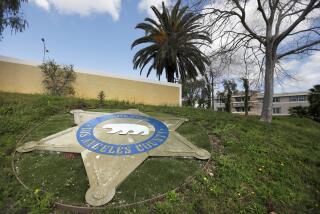‘Eviction Notice’ Aimed at Gangs
- Share via
San Bernardino County officials said they were issuing an “eviction notice” to the county’s gangs Tuesday with a $5.5-million initiative that will restore the sheriff’s gang unit and add prosecutors to crack down on street thugs.
More than 287 gangs, totaling 12,000 to 16,000 members, operate in the county and prey on the region’s fast-growing population, law enforcement officials told the Board of Supervisors. Many gang members come to the county because of low-cost housing and the “Los Angeles effect”-- members from L.A. moving inland to escape police scrutiny, they said.
“We are declaring war on gangs,” said Dist. Atty. Michael A. Ramos at a news conference in front of the County Government Center.
The program, which will be funded primarily by sales tax revenue, will include about $1 million each for the sheriff, district attorney, public defender and probation departments. The remainder of the funds will purchase equipment such as sheriff’s vehicles.
“I couldn’t be more in favor of this motion if it were a motion to save the world,” said Ginny Jablonski, who told the board that gang members had assaulted her daughter.
To some experts, however, the effectiveness of similar anti-gang programs remains unclear, since the results are rarely studied.
“There is no evidence if this works or not,” said gang expert Malcolm Klein, a USC professor emeritus.
Gangs tend to form in poor areas where middle-class institutions, such as scouting, are few, and they provide support and protection for their members, Klein said. Law enforcement crackdowns could bond them more tightly.
“Gangs love enemies,” he said. “The best enemy is a rival gang. The second best are authority figures.”
Gang membership is generally from one to three years, so jailing older gang members simply leaves a vacuum that younger members fill, Klein said.
Officials said the program would be evaluated to determine the number of arrests and case filings, and whether targeted areas showed a drop in crime.
The Sheriff’s Department plans to hire 10 people to form two anti-gang units. One of the positions is a crime analyst who will track gang patterns. The department has also reactivated its unit called SMASH: San Bernardino County Movement Against Street Hoodlums. It had been disbanded in the late 1990s for budgetary reasons.
The district attorney, who called gang members “local terrorists,” will add 16 lawyers, investigators and witness advocates to his office.
Officials expect the program to produce 1,000 to 3,000 more felony filings.
The Public Defender’s office is adding nine people, and the Probation Department, which monitors thousands of gang members, will hire 13. Officials consider probation’s role to be prevention because it offers educational programs for middle and elementary schools.
Criminologist Cheryl Maxson, a UC Irvine professor, surveyed hundreds of residents in the city of San Bernardino over two years to determine if gang injunctions -- court orders restricting gang members’ rights such as the right to assemble within a specified area -- made them feel more secure.
Residents near injunction areas said they felt somewhat safer, and that they saw slightly fewer signs of gang activity, Maxson said. But she cautioned against being too optimistic.
“Law enforcement -- it’s their job to put people in prison. The community’s challenge is how to deal with the problem long-term,” she said. “You’re not going to put everyone in prison forever.”
More to Read
Sign up for Essential California
The most important California stories and recommendations in your inbox every morning.
You may occasionally receive promotional content from the Los Angeles Times.










